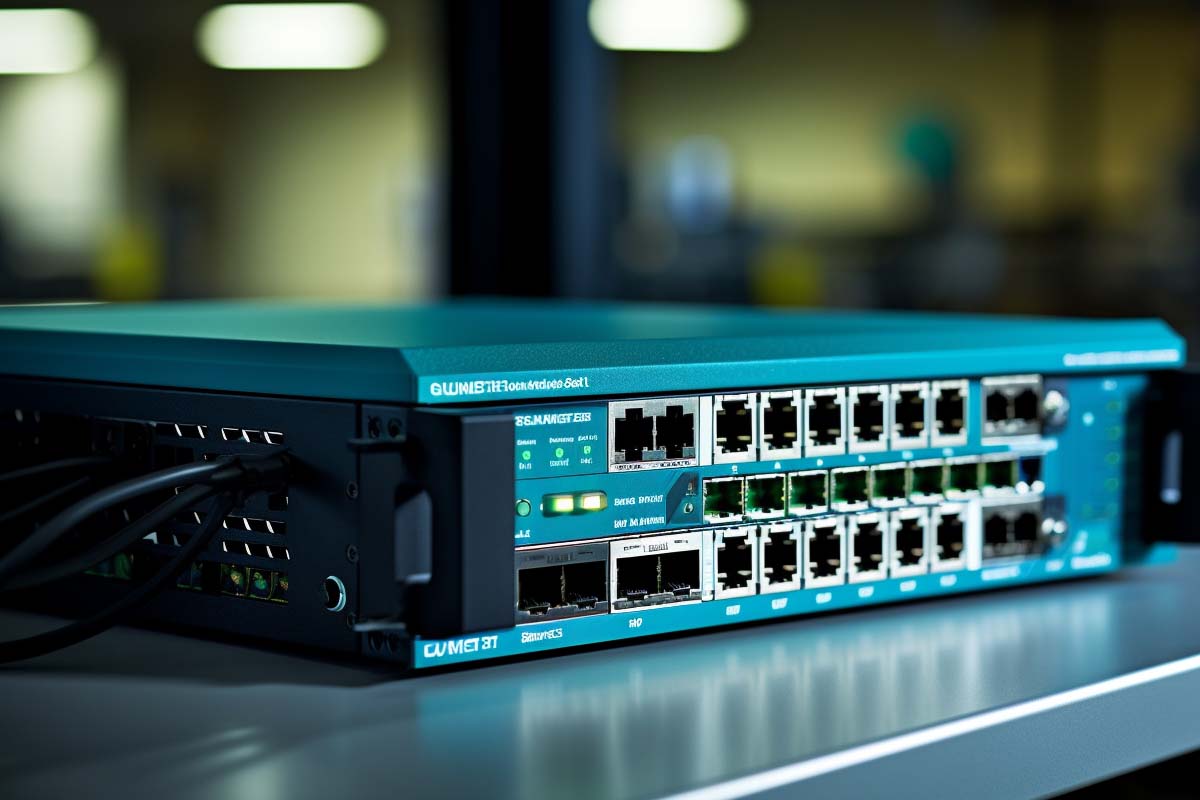An Adaptive Security Appliance (Cisco ASA) is a network security device from Cisco. It’s primarily used for firewall protection, but it also offers several other security features. Here’s how an ASA secures a network:
- Firewall Protection: The primary function of an ASA is to act as a firewall. It controls incoming and outgoing network traffic based on an applied rule set and establishes a barrier between a trusted, secure internal network and the internet or less secure external network.
- VPN Support: ASA provides Virtual Private Network (VPN) support, enabling secure remote access to the network. Users can securely connect to the network over the internet, ensuring data confidentiality and integrity.
- Intrusion Prevention and Detection: ASA can detect and prevent attempts to intrude into the network. It uses threat detection techniques and signatures to identify and block malicious traffic and activities.
- Application Awareness: ASA can control and inspect the traffic at the application layer. It recognizes and processes a wide range of applications and protocols, making the security measures more comprehensive.
- Identity Management: The ASA integrates with identity management solutions to control access based on user identity. This ensures that only authorized users and devices can access network resources.
- Content Filtering: ASA can filter unwanted content, such as spam or harmful websites, providing additional protection against web-based threats.
- Quality of Service (QoS) Management: While not a direct security feature, QoS in ASA can prioritize critical network traffic, which is important for maintaining network performance, especially during a security event.
- SSL and TLS Inspection: ASA can decrypt SSL and TLS traffic to inspect the data for threats. This is vital as more and more web traffic is encrypted.
- Network Segmentation: It supports the creation of multiple security zones for better control and segmentation of network traffic.
- Threat Intelligence Support: ASA can integrate with threat intelligence services to receive updates about emerging threats, enhancing its ability to protect against new and evolving attacks.
In summary, Cisco’s ASA is a versatile tool that combines the roles of a firewall, VPN gateway, intrusion prevention system, and more, to provide a comprehensive network security solution. Let’s dive deeper into each feature to learn how it secures a network.
Cisco Network Enginner Career Path
Targeting Cisco specific Networks, this Cisco Network Engineer Training series provides in-depth curriculum for those wanting to learn networking basics and advance his/her career opportunities as a Cisco Network Engineer.
Firewall Protection
How Cisco ASA Works as a Firewall
The Cisco ASA, acting as a firewall, is the frontline defense of a network against external threats. It scrutinizes each packet entering or leaving the network, determining whether to allow or block it based on predefined security rules. This process is essential for protecting the integrity and confidentiality of the network.
Features
- Stateful Inspection: Unlike simpler, stateless firewalls, Cisco ASA tracks the state of active connections. This means it not only examines individual packets but also understands the context of a session. For example, if a user inside the network initiates a web session, ASA allows return traffic for that session, but blocks unsolicited incoming connections.
- Access Control Lists (ACLs): Cisco ASA uses ACLs to define rules that permit or deny traffic based on IP addresses, ports, and protocols. For instance, an organization might configure ASA to allow HTTP and HTTPS traffic but block all incoming SSH requests to prevent unauthorized remote access.
- Deep Packet Inspection: ASA can inspect the contents of packets, not just the headers. This ability is crucial in identifying and blocking sophisticated attacks hidden in legitimate-looking traffic.
- Modular Policy Framework (MPF): Cisco ASA’s MPF provides a flexible and powerful way to create and apply security policies. This framework can be used, for example, to apply strict security controls on traffic to and from a sensitive database server within the network.
Real-World Applications
- Protecting an E-commerce Website: For an online retailer, Cisco ASA can be configured to allow web traffic on port 80 (HTTP) and 443 (HTTPS), while blocking potentially harmful ports and protocols. This ensures the website is accessible to customers while keeping the network secure from certain attacks.
- Securing Remote Access: In a corporate setting, Cisco ASA might be set up to allow VPN traffic, letting employees access the network remotely while blocking unauthenticated access attempts.
- Data Center Security: Cisco ASA is often used in data centers to segregate traffic between different services. For instance, it might separate traffic between a public-facing web server and an internal database server, adding a layer of protection against database attacks originating from the web server.
- Educational Institutions: Schools and universities use Cisco ASA to manage and monitor internet traffic. They might configure it to allow educational resources while blocking access to potentially harmful or distracting websites.
In these examples, the Cisco ASA’s firewall capabilities are crucial in defining the boundary of what’s allowed into the network and what’s kept out, ensuring the security of data and resources in various real-world scenarios.
VPN Support
How Cisco ASA Provides VPN Support
Cisco ASA offers robust Virtual Private Network (VPN) support, crucial for secure remote access. VPNs create a secure tunnel over the internet, allowing remote users to access a network as if they were directly connected to it, with encryption ensuring the confidentiality and integrity of data in transit.
Features
- IPsec VPN: Cisco ASA supports IPsec (Internet Protocol Security) VPNs for site-to-site connections. It’s widely used to securely connect branch offices to a central office. The ASA encrypts and decrypts traffic entering and leaving the network, ensuring secure communication over the public internet.
- SSL VPN: For individual remote users, Cisco ASA offers SSL (Secure Sockets Layer) VPN capabilities. This is typically used for providing secure access to employees working from home or traveling. Users can connect using a web browser or a client, benefiting from a secure connection without needing full network access.
- Advanced Encryption: The ASA provides a range of encryption options, including AES (Advanced Encryption Standard), which is crucial for protecting sensitive data. For example, a financial institution might use high-strength encryption to secure communications containing sensitive client data.
- Remote Access VPN: Cisco ASA can be configured for remote access VPN, allowing employees to connect to the corporate network securely from any location. This feature uses strong authentication methods to ensure that only authorized users gain access.
Real-World Applications
- Corporate Remote Work: A company with a distributed workforce uses Cisco ASA to provide secure, remote access to its network. Employees working from home can securely connect to corporate resources as if they were in the office, ensuring business continuity and data security.
- Inter-Branch Connectivity: Businesses with multiple locations use Cisco ASA to establish secure site-to-site VPN connections. This allows seamless and secure communication and data sharing between branches, essential for operations and collaboration.
- Secure Client Access: For businesses that need to provide secure access to external partners or clients, Cisco ASA’s VPN capabilities allow controlled and encrypted access to specific parts of the network.
- Educational Institutions: Universities and schools employ Cisco ASA for secure remote access to academic resources. Students and faculty can access libraries, databases, and other educational tools securely from off-campus.
In these scenarios, Cisco ASA’s VPN support plays a critical role in ensuring secure, encrypted connectivity for remote access, which is increasingly important in today’s mobile and distributed work environments.
Network Administrator Career Path
This comprehensive training series is designed to provide both new and experienced network administrators with a robust skillset enabling you to manager current and networks of the future.
Intrusion Prevention and Detection
How Cisco ASA Manages Intrusion Prevention and Detection
Cisco ASA includes features for both intrusion prevention (IPS) and intrusion detection (IDS), providing a robust defense against unauthorized access and various cyber threats. These capabilities involve monitoring network traffic and taking action based on predefined security policies and known threat signatures.
Features
- Signature-Based Detection: Cisco ASA’s IPS can identify and respond to known attack patterns or signatures. For example, if a particular malware signature is detected in network traffic, ASA can block or flag this traffic, preventing the spread of malware.
- Anomaly-Based Detection: The ASA can also detect unusual network activity that may indicate a security threat. This includes sudden surges in traffic, unusual application behavior, or traffic on ports that are usually inactive.
- Policy Enforcement: Cisco ASA can enforce security policies that dictate how to handle suspected intrusions. For instance, if an intrusion attempt is detected, ASA can be configured to automatically drop the traffic and alert network administrators.
- Traffic Logging and Analysis: ASA logs traffic data which can be analyzed to identify patterns indicative of potential security breaches. This information is crucial for post-incident analysis and improving security measures.
Real-World Applications
- Preventing Network Attacks: In a corporate environment, Cisco ASA’s IPS feature can detect and block attacks like SQL injection or cross-site scripting, protecting sensitive corporate data.
- Monitoring Unusual Activity: In a data center, ASA can monitor for anomalies that might indicate a security breach, such as an unexpected spike in outbound traffic, which could be a sign of data exfiltration.
Application Awareness
How Cisco ASA Achieves Application Awareness
Application awareness in Cisco ASA involves the ability to recognize and manage traffic based on the applications generating it, rather than just ports and protocols. This deep understanding of application traffic is essential for effective network security in a landscape where applications are increasingly complex and cloud-based.
Features
- Application Visibility and Control (AVC): Cisco ASA can identify specific applications, allowing network administrators to create policies tailored to individual applications. For example, it can differentiate between Facebook traffic for marketing purposes and personal use.
- Granular Control: ASA provides the ability to control sub-application level features. For instance, it can allow file transfers over Skype but block video calls.
- Behavior Analysis: Cisco ASA examines the behavior of applications to detect and block threats that traditional port-based firewalls might miss. This is particularly useful in identifying and mitigating advanced persistent threats (APTs).
- Custom Application Identification: Organizations can configure Cisco ASA to recognize custom or in-house applications, enabling fine-grained control over these applications’ traffic.
Real-World Applications
- Regulating Social Media Use: In an office setting, Cisco ASA can be used to allow limited access to social media sites for work purposes while restricting personal use during business hours.
- Controlling Application Access: In a school network, ASA can be configured to allow educational applications and platforms while blocking access to gaming or entertainment apps during school hours.
- Managing Cloud Applications: For businesses using cloud services, Cisco ASA can ensure secure and efficient use of cloud applications, enforcing policies that prioritize business-critical cloud traffic.
In both intrusion prevention and detection, and application awareness, Cisco ASA plays a pivotal role in safeguarding networks against a wide array of threats, from traditional malware to sophisticated cyber attacks, and in managing the complex nature of modern application traffic.
Information Security Analyst Career Path
An Information Security Analyst plays a pivotal role in safeguarding an organization’s digital infrastructure and sensitive data. This job involves a blend of technical expertise, vigilance, and continuous learning to protect against ever-evolving cyber threats.
Identity Management
How Cisco ASA Integrates Identity Management
Cisco ASA integrates identity management to enhance network security by controlling access based on user identity. This approach moves beyond simple IP address recognition, allowing for more granular and user-specific security policies.
Features
- Integration with Identity Services: Cisco ASA can integrate with various identity management services like Active Directory, LDAP, or RADIUS. This allows for authentication and authorization based on user roles and profiles. For instance, different access levels can be granted to staff and management.
- User-Based Policy Enforcement: Policies in Cisco ASA can be applied based on user identity. For example, a network administrator might have broader access compared to a regular employee.
- VPN Access Control: When used in conjunction with VPN, Cisco ASA can provide secure remote access based on user identity, ensuring that only authorized personnel can access sensitive parts of the network.
- Logging and Auditing: Cisco ASA keeps detailed logs of user activity, which is vital for auditing, compliance, and forensic analysis in the event of a security breach.
Real-World Applications
- Corporate Network Security: In a corporate environment, Cisco ASA can enforce policies that restrict access to sensitive data based on employee roles, ensuring that only authorized personnel can access confidential information.
- Educational Institutions: Schools and universities use Cisco ASA to manage access to educational resources, providing different access levels to students, faculty, and staff.
Content Filtering
How Cisco ASA Provides Content Filtering
Content filtering in Cisco ASA involves blocking or allowing content based on specific criteria like URL, keywords, or file types. This is important for protecting against web-based threats and ensuring compliance with organizational policies.
Features
- URL Filtering: Cisco ASA can block or allow access to specific websites based on URLs. This is used to prevent access to malicious or inappropriate websites.
- Keyword Filtering: It can also filter content based on keywords, which is useful for blocking specific types of web content.
- File Type Blocking: ASA can block certain file types from being downloaded or uploaded, which helps in preventing the spread of malware.
- Regular Expressions: Cisco ASA can use regular expressions for more sophisticated content filtering, providing flexibility in defining what content should be blocked or allowed.
Real-World Applications
- Protecting Against Web Threats: Businesses use Cisco ASA to block access to phishing sites, malware-laden websites, and other harmful online content, protecting the network and end-users.
- Regulating Internet Usage: In schools, Cisco ASA can restrict access to adult content, social media, or gaming sites during school hours to maintain a focus on education.
- Compliance and Data Leakage Prevention: For organizations that need to comply with regulations like HIPAA or GDPR, Cisco ASA’s content filtering can prevent the accidental or intentional transmission of sensitive information.
In these ways, Cisco ASA’s identity management and content filtering capabilities are critical for providing secure, compliant, and efficient network usage, tailored to the specific needs and policies of an organization.
Quality of Service (QoS) Management
How Cisco ASA Manages Quality of Service
Quality of Service (QoS) in Cisco ASA involves prioritizing network traffic to ensure that critical applications and services remain stable and performant, especially during high demand or attack scenarios. This is not a direct security feature but is essential for maintaining network performance and availability.
Features
- Traffic Prioritization: Cisco ASA can prioritize certain types of traffic. For example, VoIP (Voice over IP) traffic can be given higher priority over general internet browsing, ensuring clear voice calls even under heavy network load.
- Bandwidth Management: ASA can control the amount of bandwidth allocated to different types of traffic. This is particularly useful in preventing non-critical applications from consuming excessive bandwidth.
- Congestion Management: During times of network congestion, Cisco ASA can ensure that important traffic is not dropped and continues to flow smoothly.
- Policy-Based Traffic Shaping: Specific policies can be applied to shape traffic, such as limiting or expanding bandwidth for certain applications or users, ensuring optimal network performance.
Real-World Applications
- Business Critical Applications: In a corporate environment, Cisco ASA ensures that applications like CRM and ERP systems get the necessary bandwidth, especially during peak usage times.
- Teleconferencing and Remote Work: For organizations heavily reliant on remote communication, Cisco ASA can prioritize video conferencing and VoIP traffic, making remote meetings more effective.
SSL and TLS Inspection
How Cisco ASA Performs SSL and TLS Inspection
SSL (Secure Sockets Layer) and TLS (Transport Layer Security) inspection in Cisco ASA involves decrypting encrypted traffic to inspect it for threats, then re-encrypting it before sending it to its destination. This is vital for security as more and more web traffic is encrypted.
Features
- Decryption and Inspection: Cisco ASA can decrypt SSL/TLS encrypted traffic, inspect the contents for potential threats or policy violations, and then re-encrypt the traffic.
- Certificate Inspection: ASA inspects SSL certificates to ensure they are valid and not associated with malicious sites or activities.
- Protocol Compliance: It checks that the SSL/TLS protocols are being used correctly, which can help identify attempts to use these protocols to bypass security measures.
- Policy Enforcement: Based on the inspection, ASA can enforce policies, such as blocking access to sites with invalid certificates or non-compliant encryption.
Real-World Applications
- Financial Institutions: Banks and financial firms use Cisco ASA for SSL/TLS inspection to secure transactions and protect sensitive customer data against interception or tampering.
- Healthcare Sector: For healthcare providers, Cisco ASA can inspect encrypted traffic to prevent data breaches of sensitive patient information, while complying with regulations like HIPAA.
- E-commerce Platforms: Online retailers use Cisco ASA to inspect encrypted traffic to ensure secure customer transactions and protect against data theft or fraud.
In these scenarios, Cisco ASA’s QoS management ensures optimal network performance and resource allocation, while SSL and TLS inspection plays a crucial role in maintaining the integrity and security of encrypted data, a necessity in today’s heavily encrypted internet environment.
Cisco Network Enginner Career Path
Targeting Cisco specific Networks, this Cisco Network Engineer Training series provides in-depth curriculum for those wanting to learn networking basics and advance his/her career opportunities as a Cisco Network Engineer.
Network Segmentation
How Cisco ASA Facilitates Network Segmentation
Cisco ASA plays a critical role in network segmentation, which involves dividing a network into smaller, distinct segments or subnetworks. This segmentation enhances security by limiting the spread of threats and reducing the attack surface.
Features
- Virtual LANs (VLANs): Cisco ASA can enforce rules and policies across different VLANs. For example, it can separate a network into a VLAN for employee devices and another for guest access, each with its own security policies.
- Security Zones: ASA allows the creation of multiple security zones, each with its own set of access controls and policies. Sensitive areas of a network, like a payment processing system, can be isolated to ensure higher security.
- Access Control Between Segments: Cisco ASA can control traffic between different network segments, allowing only authorized communication. This is crucial in preventing lateral movement of threats within the network.
- Subnet-Based Policies: Policies can be applied based on subnets, enabling granular control over network traffic and enhancing security within segmented network areas.
Real-World Applications
- Corporate Network Protection: A company can use Cisco ASA to separate its internal network from public-facing servers. This ensures that if a public server is compromised, the threat does not easily spread to the internal network.
- Compliance in Financial Institutions: Banks can segment their networks to isolate customer data and internal financial systems from less sensitive areas, a practice that helps in compliance with financial regulations.
Threat Intelligence Support
How Cisco ASA Utilizes Threat Intelligence
Cisco ASA integrates threat intelligence to enhance its security capabilities. This involves using information about existing and emerging threats to proactively defend against them.
Features
- Integration with Threat Intelligence Feeds: Cisco ASA can integrate with external threat intelligence feeds, staying updated on the latest threats and attack vectors.
- Dynamic Security Updates: The ASA can receive and implement updates about new threats, adjusting its security measures in real-time to protect against these threats.
- Global Threat Intelligence: Through Cisco’s security services, ASA benefits from global threat intelligence, which includes data from a wide array of sources, offering a comprehensive view of the threat landscape.
- Context-Aware Security: The threat intelligence enables Cisco ASA to make more informed decisions about security, considering the context of the threat in relation to the network it’s protecting.
Real-World Applications
- Preventing Advanced Cyber Attacks: Businesses use Cisco ASA’s threat intelligence capabilities to protect against sophisticated cyber-attacks, staying one step ahead of attackers.
- Healthcare Data Protection: Hospitals and healthcare providers utilize this feature to safeguard patient data against emerging malware and ransomware threats.
- Retail and E-commerce Security: Retailers leverage threat intelligence to secure their online platforms and customer data from the latest threats, including phishing and DDoS attacks.
In summary, network segmentation through Cisco ASA ensures enhanced security by dividing the network into manageable and secure segments, limiting the spread of threats. Meanwhile, threat intelligence support empowers Cisco ASA with the latest information on potential security threats, enabling proactive defense measures. These capabilities are crucial in today’s complex and ever-evolving cyber threat landscape.
Frequently Asked Questions Related to the Cisco ASA
What is Cisco ASA?
Cisco ASA (Adaptive Security Appliance) is a network security device widely used in various organizations. It combines firewall, intrusion prevention system (IPS), antivirus, VPN (Virtual Private Network), and several other security functions. Its primary role is to protect network environments from threats and unauthorized access, while also managing traffic and user access. Cisco ASA is highly regarded for its robust security capabilities, flexibility, and scalability in different network environments.
How to check CDP neighbors in Cisco ASA?
To check CDP (Cisco Discovery Protocol) neighbors in a Cisco ASA, you need to access the ASA’s command-line interface (CLI). Once logged in, you can use the command show cdp neighbors. This command will display a list of all neighboring devices detected by CDP, providing details such as device IDs, local and remote interfaces, hold time, and platform information. This is useful for network administrators to understand the network topology and connected Cisco devices.
What are the key features of Cisco ASA?
Cisco ASA offers a range of features focused on network security. Key features include a stateful firewall, VPN support for secure remote access, intrusion prevention and detection, application awareness for fine-grained traffic control, identity management for user-based access control, content filtering, Quality of Service (QoS) management, SSL and TLS inspection, network segmentation for enhanced security, and integration with threat intelligence for proactive defense against emerging threats.
How does Cisco ASA differ from a traditional firewall?
Cisco ASA stands out from traditional firewalls due to its comprehensive security features. While a traditional firewall primarily focuses on monitoring and controlling incoming and outgoing network traffic based on predetermined security rules, Cisco ASA offers advanced capabilities like VPN support, intrusion prevention, application-level inspection, identity management, and integration with global threat intelligence. These features provide a more holistic and adaptable approach to network security.
What types of VPN does Cisco ASA support?
Cisco ASA supports various types of VPN configurations, including Site-to-Site VPNs, Remote Access VPNs using IPsec and SSL, and clientless SSL VPNs. This versatility allows organizations to securely connect branch offices, enable remote workers, and provide limited network access to external users through a web browser.













